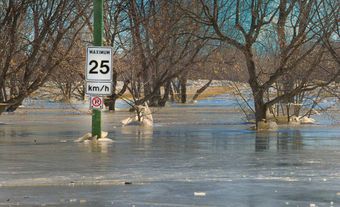Three Swedish names appeared among Lord Selkirk's group of settlers in the Red River Valley of Manitoba, the first evidence of Swedish settlers in Canada (see Red River Colony.) From 1868 to 1914, more than one million Swedes moved to the United States and Canada.

Land opportunities in the United States attracted Swedish immigrants in the late 19th and early 20th centuries, but as farmland became scarce and costly in the American West, they began to migrate to the Canadian West. In 1971 there were 101,870 people of Swedish Canadian origin and by 1981 their number had decreased to 78,360. The 2016 census reported 349,645 people of Swedish origin in Canada (21,775 single responses and 327,870 multiple responses) (see also Immigration in Canada.)
Origins
In the early years of the 19th century, Sweden experienced a rapid growth in population. A very large segment of the agrarian population became landless and social divisions between the propertied and landless classes hardened. Many Swedish farmers sought opportunities elsewhere. A series of crop failures (1866-68) brought starvation and economic hardship to many parts of Sweden and provided an added impetus to emigration.
Migration and Settlement
The greatest proportion of the more than one million Swedish emigrants were landless labourers and the sons and daughters of small landholders and crofters. The state Lutheran Church in Sweden actively encouraged the poor and destitute to emigrate. Labour organizers blacklisted by their employers in Sweden also left, and as women became more economically emancipated, many found their way overseas. Emigration promoters from the US and Canada worked actively in Sweden to attract settlers.
Until 1914, most Swedish immigrants arrived in Canada primarily from Minnesota and North Dakota. Between 1921 and 1930, over 20,000 Swedes (many of them industrial workers) migrated directly to Canada. By 1930, Sweden had developed a large industrial base, and since 1945 Swedish migration to Canada has been primarily on an individual basis.
In the early 1870s, some Swedes travelled by boat along the Red River to Winnipeg. With the completion of the Canadian Pacific Railway, many Swedes took advantage of the Canadian government policy offering inexpensive Prairie farmland (see also Immigration Policy in Canada.) Winnipeg attracted many Swedish immigrants and for years it was the main centre for most nationwide Swedish organizations. Swedes in Manitoba settled as well in Scandinavia, Erickson, Teulon, Mulvihill and Eriksdale. Saskatchewan also attracted Swedish settlers; one of every four Swedes listed in the 1931 census lived in that province, particularly in the Qu'Appelle Valley communities of Stockholm and Dubuc (see Fort Qu’Appelle; Qu’Appelle River). Swedes settled in Alberta before it became a province, and Swedish communities still exist in Edmonton and Calgary. During the Second World War (WWII) many Swedes moved west to the Pacific coast because of the milder climate and job opportunities. Today, British Columbia has the largest number of Swedish Canadians.
Many early Swedish immigrants settled in northwestern Ontario as farmers and lumber workers, particularly around Kenora; after the Second World War a large number of Swedish immigrants settled in Toronto.
Economic Life
The great majority of the early Swedish immigrants to Canada were attracted by the opportunity of owning farmland. Around the turn of the century, skilled and unskilled workers immigrated to the urban-industrial areas of Canada. After 1945 Swedish immigrants included engineers, businessmen and representatives of Swedish export industries. Over the years, large numbers of Swedish Canadians moved from farms into industry, business and the professions.
Social Life and Community
Swedish settlers, especially in western Canada, established several social clubs and organizations. Temperance societies established in a number of communities were among the first Swedish-language clubs. In 1901 the Norden Society was organized as a benefit society.
The Vasa Order of America, now a social and cultural organization, was founded in 1896 in the US and in 1913 in Canada as a mutual-benefit society; it maintains lodges throughout the US and Canada.
Religion and Cultural Life
Much of the religious and cultural life of the early Swedish communities in Canada centered around churches, which became bastions of the Swedish language and provided a cultural link between Swedish immigrants and their Canadian-born children. For many immigrants, religious dissension in the homeland had been a major factor for leaving Sweden and it affected their choice of religious denomination in North America.
The Lutheran Church has been the strongest church organization in North America among Swedes. In 1860 the Swedish Lutheran congregations in the US established the Augustana Synod which, for over a century, guided Swedish Lutheran activities throughout Canada and the US before becoming the Lutheran Church in America. The Canada Conference of the Augustana Evangelical Lutheran Church was located in Winnipeg.
Canada-Tidningen (established in Winnipeg in 1892), was the longest-running and most influential Swedish-language newspaper in Canada. In 1970 it amalgamated with the Swedish-American Tribune of Chicago. Several other Swedish-language periodicals have been published, in Winnipeg, Vancouver and Toronto.
Education and Language
The children of the early Swedish settlers adapted readily to the Canadian educational system and to the English language. The 2016 census recorded 7,525 Canadians whose mother tongue (first language learned) was Swedish.
Politics
Many Swedish Canadians actively participated in community activities such as co-operatives, credit unions and wheat pools of the Prairie provinces, and in the early BC trade-union movement. Many Swedes supported populist movements such as the Co-operative Commonwealth Federation in Saskatchewan and Social Credit in Alberta. Harry Strom, former Social Credit premier of Alberta (1968-71), was of Swedish origin.

 Share on Facebook
Share on Facebook Share on X
Share on X Share by Email
Share by Email Share on Google Classroom
Share on Google Classroom




